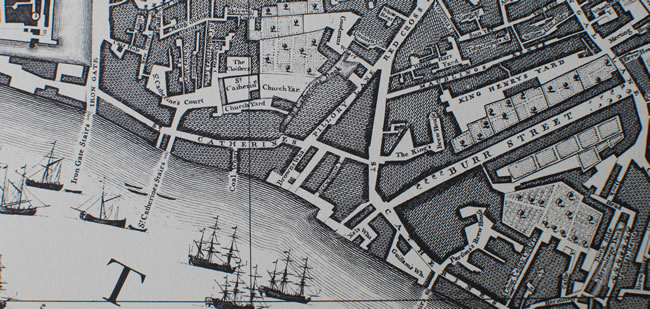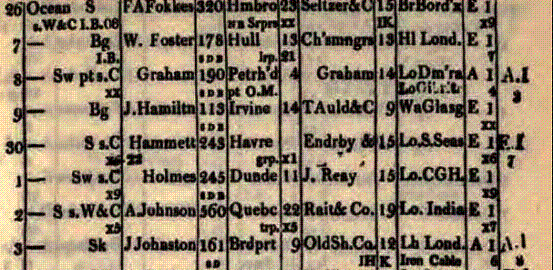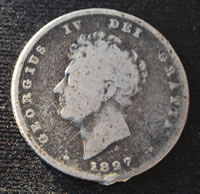| John Johnston | |
|
Memorabilia
|
John Johnston and Sarah Ainslie were married in Leith early in the nineteenth century. John was described as a sailor when their children were born: Isabella in 1809, Johanne in 1812, and John in 1814. Then, on Monday November 13th 1826, his death was reported in the Caledonian Mercury as follows: "At London, on the 4th current, in two days illness, and much regretted by all his friends and acquaintances, John Johnston, captain of the London and Leith Shipping Company’s smack Ocean." There is a parish record which may well refer to the captain. It comes from St Botolph-without-Aldgate and records the burial of John Johnson, aged 56, on 8 November 1826. The incorrect spelling is hardly a problem since his daughter Isabella's marriage certificate omits the "t" whereas the register includes it. John's address is given as Burr Street, which at the time ran towards the Thames, just east of the Tower of London. The remaining portion is now called Burr Close. In the 1825 edition of The Edinburgh Almanack the London wharf used by the Old Shipping Company was listed as the Leith and Berwick Wharf. This wharf could be found at "Lower East Smithfield - nearly op. Burr St. about 1/5 mile below the Tower" according to the 1810 edition of Lockie's Topography of London. (On 2 July 1827 a notice appeared in the Glasgow Herald informing the public that henceforth the London and Leith Old Shipping Company would be using the "more commodious premises at Irongate Wharf, immediately to the East of the Tower, conveniently situated for Shippers, being higher up the River and nearer the City that their former Wharf"). When John Johnston fell ill on 2nd November while his smack was tied up at the Leith and Berwick Wharf, he might well have been staying in, or taken to, lodgings on Burr Street, in the parish of St Botolph-without-Aldgate. Then when he died on the 4th November, the local agent for the company, Andrew Lawrie/Laurie, would probably have arranged for his burial at the local parish church. The map below, by John Rocque, dates from the 18th century but it shows the location of Burr Street running SW down towards the Thames, and Iron Gate adjacent to the Tower of London. There are two wharves marked that could be said to be nearly opposite Burr Street.
John must have become a shipmaster, as he was described on his daughter's marriage certificate in 1830, some time after the birth of his son in 1814. It may be possible to narrow down the date of his promotion, for example, by studying the Leith Shipping lists. Items such as "Ocean, Johnston, at London 27th inst. from Leith" appeared regularly in the Caledonian Mercury. However the same lists show that he was not the only captain named Johnston sailing out of Leith: Moses Johnston was master of the Roxburgh in1805 and of the Swift in 1815 and one issue of the paper in 1817 recorded that the masters of the Caledonia and the Lively were both named Johnston. The Caledonia may well have been John Johnston's first command. In a letter from James Hyslop to his brother Simon, living at Langholm, which was written in London and dated 21 May 1818, there is mention of some wine "put on board the Caledonia, John Johnston, Master, per Leith". The whole letter may be read by following this link to the website of the Langhohm Archive Group. Scroll down to the last letter on the page to discover more about the contents of the hamper sent by James Hyslop, including instructions should there be breakages. The earliest reference in the Caledonian Mercury to Johnston being on the Caledonia is on 17 August 1811. The last one is 21 June 1819, just before the first mention of Johnston being master of the Ocean on 10 July 1819. Before that the master of Ocean is named as Crichton (10 June 1819), and after that the master of the Caledonia is Crabb (5 August 1819). Further information may be found in a record of Masters of Merchantmen, dated 1822. This was issued annually by the Society for the Registry of Shipping and it lists all ships that were surveyed before being insured. In the extract below, the last line tells us quite a bit about the Ocean including the fact that, according to the number in the first column, it was the 33rd merchant ship with a name beginning with "O" to be listed in the document. Ships with the same name were listed in alphabetical order of their masters.
From the next two columns we learn that it was a smack (Sk) and that the master was J Johnston. Then follow the tonnage (161); number of decks (SD - single deck); place built (Bridport); age (9 years); the owners (Old Shipping Company); draught when loaded (12 feet) and the voyage for which the ship was surveyed (Leith to London). Both vessel classification and stores classification were first class (A 1). The cargo appears to include " iron cable". It is interesting that the Ocean was built in Bridport, Dorset, but was destined to be sailed on the North Sea route between Leith and London. The same year, the Ocean was mentioned in a letter to Sir Walter Scott from Archibald Constable, his publisher. It was written on 31 May 1822 and refers to the arrival in London of the first copies of Scott's latest novel, "The Fortunes of Nigel". "The smack Ocean, by which the new work was shipped, arrived at the wharf on Sunday ; the bales were got out by one on Monday morning, and before half-past ten o'clock 7000 copies had been dispersed from 90 Cheapside." Hard work for a Sunday night.
Yet another reference to the Ocean appears in a book by Robert Mudie published in 1822 following a visit by King George IV to Scotland in August of that year. Mudie was a reporter for the Morning Chronicle at the time and covered the events in great detail, recording in "A historical account of His Majesty's visit to Scotland" everything from the early planning and preparations through to the King's return to London. Describing the scene as the King's yacht approached Greenwich, Mudie wrote the following:
"We must not forget to notice, that a hearty welcome was given to his Majesty by the passengers and crew of the Leith Old Shipping Company's smack Ocean, Captain Johnstone. The latter, proud of the honour done his country by the royal visit, was anxious to shew his Majesty every respect. On approaching the royal squadron at Blackwall, he ordered the sails to be lowered, and manned the rigging; and on passing the royal yacht, all on board cheered his Majesty in the most cordial manner." Because Robert Mudie was such a stickler for detail we know this happened between 3.20 pm and 3.50 pm on Sunday 1st September 1822. _______________________ The Leith smack was a well-respected ship design at the time. According to "Old and New Edinburgh" by James Grant, they were "large and beautiful cutters, carrying an enormous spread of fore and aft canvas". The same source also explains why they were well armed: "On the 9th January, 1805, another (smack), the Swallow, Captain White, was attacked off Flamborough Head by a heavy French privateer, carrying fourteen guns and very full of men. Passing through a fleet of Newcastle colliers, she came within pistol shot of the Swallow, and poured in a broadside, accompanied by volleys of musketry. Captain White replied with his carronades and small arms. The round shot of the former told so well that the privateer was fairly beaten off, while neither the smack nor her crew sustained much injury." Encounters such as this were "of very common occurrence in those days." For more about Leith and its maritime history explore the web site History of Leith or browse Old and New Edinburgh and search for key words in this web version of a fascinating 1880s periodical. In “Reminiscences of the Port and Town of Leith” by John Martine 1888, it is stated that the fleet of smacks that included the Ocean all had a broad streak of white paint on their sides and were called “White siders”. The berth and offices of these vessels were exactly at the foot of Queen Street. From the picture and map it appears that the ships on the left are smacks of the London and Leith Old Shipping Company and the building on the right is the company’s office. A broad white stripe is visible on the nearest ship and the shape of both the dock and the building line matches the map, with its conveniently labelled company office. Originally, the company was based in Berwick and traded between there and London. Passengers and goods were trans-shipped or carried overland between Berwick and Leith. Eventually the company was transferred to Leith and traded from there. In “Reminiscences” we learn that “the Berwick names of Nesbitt, Crabb, Johnston, Charters, Crow, etc. were long known in Leith.” So perhaps John Johnston’s family originated in Berwick rather than Leith where he was apparently born.
|
| Top of Page |




